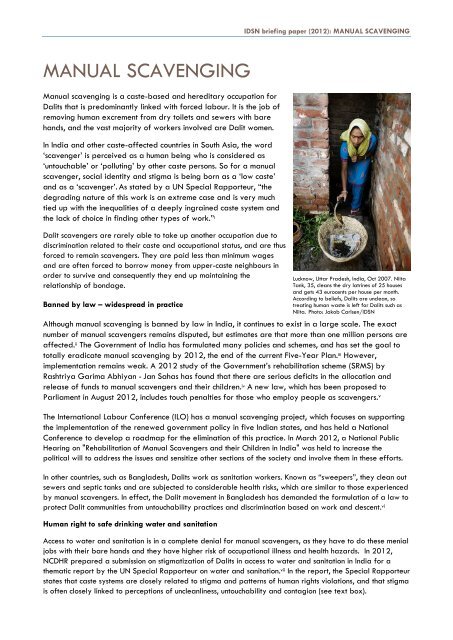IDSN BRIEFING PAPER (2012): Manual scavenging
IDSN BRIEFING PAPER (2012): Manual scavenging
IDSN BRIEFING PAPER (2012): Manual scavenging
Create successful ePaper yourself
Turn your PDF publications into a flip-book with our unique Google optimized e-Paper software.
<strong>IDSN</strong> briefing paper (<strong>2012</strong>): MANUAL SCAVENGING<br />
MANUAL SCAVENGING<br />
<strong>Manual</strong> <strong>scavenging</strong> is a caste-based and hereditary occupation for<br />
Dalits that is predominantly linked with forced labour. It is the job of<br />
removing human excrement from dry toilets and sewers with bare<br />
hands, and the vast majority of workers involved are Dalit women.<br />
In India and other caste-affected countries in South Asia, the word<br />
‘scavenger’ is perceived as a human being who is considered as<br />
‘untouchable’ or ‘polluting’ by other caste persons. So for a manual<br />
scavenger, social identity and stigma is being born as a ‘low caste’<br />
and as a ‘scavenger’. As stated by a UN Special Rapporteur, “the<br />
degrading nature of this work is an extreme case and is very much<br />
tied up with the inequalities of a deeply ingrained caste system and<br />
the lack of choice in finding other types of work.” i<br />
Dalit scavengers are rarely able to take up another occupation due to<br />
discrimination related to their caste and occupational status, and are thus<br />
forced to remain scavengers. They are paid less than minimum wages<br />
and are often forced to borrow money from upper-caste neighbours in<br />
order to survive and consequently they end up maintaining the<br />
relationship of bondage.<br />
Banned by law – widespread in practice<br />
Although manual <strong>scavenging</strong> is banned by law in India, it continues to exist in a large scale. The exact<br />
number of manual scavengers remains disputed, but estimates are that more than one million persons are<br />
affected. ii The Government of India has formulated many policies and schemes, and has set the goal to<br />
totally eradicate manual <strong>scavenging</strong> by <strong>2012</strong>, the end of the current Five-Year Plan. iii However,<br />
implementation remains weak. A <strong>2012</strong> study of the Government’s rehabilitation scheme (SRMS) by<br />
Rashtriya Garima Abhiyan - Jan Sahas has found that there are serious deficits in the allocation and<br />
release of funds to manual scavengers and their children. iv A new law, which has been proposed to<br />
Parliament in August <strong>2012</strong>, includes touch penalties for those who employ people as scavengers. v<br />
The International Labour Conference (ILO) has a manual <strong>scavenging</strong> project, which focuses on supporting<br />
the implementation of the renewed government policy in five Indian states, and has held a National<br />
Conference to develop a roadmap for the elimination of this practice. In March <strong>2012</strong>, a National Public<br />
Hearing on "Rehabilitation of <strong>Manual</strong> Scavengers and their Children in India" was held to increase the<br />
political will to address the issues and sensitize other sections of the society and involve them in these efforts.<br />
In other countries, such as Bangladesh, Dalits work as sanitation workers. Known as “sweepers”, they clean out<br />
sewers and septic tanks and are subjected to considerable health risks, which are similar to those experienced<br />
by manual scavengers. In effect, the Dalit movement in Bangladesh has demanded the formulation of a law to<br />
protect Dalit communities from untouchability practices and discrimination based on work and descent. vi<br />
Human right to safe drinking water and sanitation<br />
Lucknow, Uttar Pradesh, India, Oct 2007. Niita<br />
Tank, 35, cleans the dry latrines of 25 houses<br />
and gets 43 eurocents per house per month.<br />
According to beliefs, Dalits are unclean, so<br />
treating human waste is left for Dalits such as<br />
Niita. Photo: Jakob Carlsen/<strong>IDSN</strong><br />
Access to water and sanitation is in a complete denial for manual scavengers, as they have to do these menial<br />
jobs with their bare hands and they have higher risk of occupational illness and health hazards. In <strong>2012</strong>,<br />
NCDHR prepared a submission on stigmatization of Dalits in access to water and sanitation in India for a<br />
thematic report by the UN Special Rapporteur on water and sanitation. vii In the report, the Special Rapporteur<br />
states that caste systems are closely related to stigma and patterns of human rights violations, and that stigma<br />
is often closely linked to perceptions of uncleanliness, untouchability and contagion (see text box).
<strong>IDSN</strong> briefing paper: DALIT HUMAN RIGHTS DEFENDERS<br />
TEXT BOX: Report of the UN Special Rapporteur on water and sanitation (A/HRC/21/42)<br />
21 st session of the Human Rights Council (Sept <strong>2012</strong>)<br />
33. Dalits are regularly forced into the most menial, socially degrading, dirty and hazardous jobs. Some Dalits, in<br />
particular women, work as manual scavengers or sweepers; the terminology varies across countries, but generally refers<br />
to those who clean faeces from dry toilets.15 As a result of their direct contact with human faeces, manual scavengers<br />
suffer from a range of health problems (A/HRC/15/55 and Corr.1, para. 75) that are for the most part left untreated<br />
and add further to their stigmatization. <strong>Manual</strong> scavengers and sweepers suffer extreme forms of social exclusion, even<br />
within their own caste. These practices are not only deeply rooted in society, but also institutionalized through State<br />
practice, with municipalities themselves employing sweepers (ibid.). Moreover, patterns of stigmatization are<br />
perpetuated in schools, being reflected in the nature of cleaning duties, namely, through the assignment of toilet<br />
cleaning to the “lower” castes. Instead of breaking caste barriers, teachers perpetuate stigmatization, limiting the rights<br />
of young people to be free from discrimination and to access education.<br />
RECOMMENDATIONS<br />
<br />
Draft UN Principles and Guidelines for the effective elimination of discrimination based on work and<br />
descent – a comprehensive framework to address caste-based discrimination. Published by the UN<br />
Human Rights Council in 2009 (A/HRC/11/CRP.3)<br />
Joint Declaration and Global Call for Action to Eliminate Caste-Based Discrimination (<strong>IDSN</strong>, 2011)<br />
Report on Good Practices and Strategies to Eliminate Caste-Based Discrimination (<strong>IDSN</strong>, <strong>2012</strong>)<br />
KEY RESOURCES<br />
<strong>IDSN</strong>’s Database - documents on manual <strong>scavenging</strong>: http://delicious.com/idsn/manual-<strong>scavenging</strong><br />
Employers of manual scavengers to face prison (<strong>IDSN</strong> News August <strong>2012</strong>)<br />
Parliamentarians in India raise their voices for the eradication of manual <strong>scavenging</strong> (<strong>IDSN</strong> News May<br />
<strong>2012</strong>)<br />
<strong>Manual</strong> Scavenging highlighted by ILO and others in conferences, reports and a hearing (<strong>IDSN</strong> News<br />
April <strong>2012</strong>)<br />
Written statement, 21 st HRC session (IMADR, NCDHR and <strong>IDSN</strong>): “Stigma, “untouchability” and castebased<br />
discrimination”<br />
Submission on stigmatization of Dalits in access to water and sanitation in India (NCDHR, <strong>2012</strong>)<br />
Stigma and manual <strong>scavenging</strong> – Note by Safai Kamachari Andolan (<strong>2012</strong>)<br />
Study on rehabilitation of manual scavengers (implementation status of SRMS scheme) and “ Note on<br />
Uncompleted and unsuccessful rehabilitation by Rashtriya Garima Abhiyan – Jan Sahas (<strong>2012</strong>)<br />
ILO Project: Promotion of Equality at Work in India (good practice case, <strong>IDSN</strong> Consultation 2011)<br />
Garima Abhiyan - A story of Change (Jan Sahas) (good practice case, <strong>IDSN</strong> Consultation 2011)<br />
Steps towards the Elimination and Eradication of <strong>Manual</strong> Scavenging Practice - a manual for Advocacy<br />
on <strong>Manual</strong> Scavenging. Advocacy Plan on the Eradication of the practice of <strong>Manual</strong> Scavenging.<br />
Lesson series published by the Human Rights Correspondance School: An examination of the situation<br />
faced by Dalit communities working as manual scavengers and manhole workers<br />
i<br />
The Good Practice Book “On the Right Track” released by the UN Special Rapporteur on Water and Sanitation (Lisbon, February <strong>2012</strong>)<br />
ii<br />
According to the Census of India 2011, there are still 794,390 dry latrines in the country, where human excreta are cleaned up by humans. Apart<br />
from these there are 1,314,652 toilets where the human excreta is flushed in open drains. The census also adds that there are 497,236 toilets in the<br />
country where the human excreta is cleaned up by animals through eating it. Thus there are more than 26 lakhs [2.6 million] dry latrines in the country<br />
where the practice of manual <strong>scavenging</strong> still continues. Source: Uncompleted and unsuccessful rehabilitation of manual scavengers (Jan Sahas <strong>2012</strong>)<br />
iii<br />
As per a Public Interest Litigation filed in the High court of Delhi, Indian Railways managed by the Govt. of India, which employs a large number<br />
manual scavengers, is a violator of the Employment of <strong>Manual</strong> Scavengers and Construction of Dry Latrines (Prohibition) Act of 1993. Despite<br />
recommendations from the ILO Expert Committee on Conventions regarding Convention no. 111 in 2002 which looked into questions related to manual<br />
<strong>scavenging</strong>, this pernicious practice still continues.<br />
iv<br />
Study on rehabilitation of manual scavengers (implementation status of SRMS scheme) in India by Rashtriya Garima Abhiyan – Jan Sahas (<strong>2012</strong>) and<br />
“Brief Note on Uncompleted and unsuccessful rehabilitation of manual scavengers in India”<br />
v Employers of manual scavengers to face prison (<strong>IDSN</strong> News August <strong>2012</strong>)<br />
vi<br />
Demands by the Bangladesh Dalit and Excluded Rights Movement (BDERM) and Bangladesh Dalit and Excluded Women's Federation (BDEWF). See<br />
news story: http://www.thedailystar.net/newDesign/news-details.php?nid=240444<br />
vii Submission on stigmatization of Dalits in access to water and sanitation in India (NCDHR, <strong>2012</strong>)

















